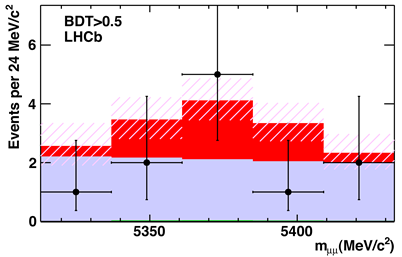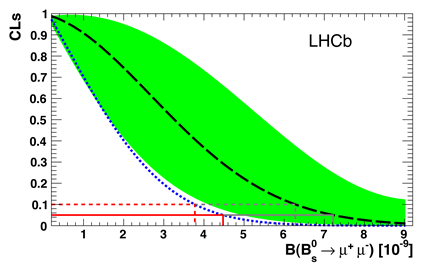[ Branching ratio B0s →μμ < 4.5×10-9 at 95% CL ]
The LHCb collaboration has announced today at the Rencontres de Moriond EW conference one of the most hotly anticipated results from the LHC. LHCb has shown that the frequency with which a Bs meson decays into a pair of oppositely charged muons is not larger than 4.5 times out of one billion decays. Theorists have calculated that, in the Standard Model, this decay should occur about 3 times in every billion, but that if new particles predicted by theories such as supersymmetry exist, the decay could occur much more often (see news items of 8 April and 22 July 2011 for more details). The new results represent a milestone in the search for “new physics” beyond the Standard Model.
click the image for higher resolution
The left figure shows the mass calculated from the two muons for events that survive all selection requirements. The blue area shows the shape of random combinations of muons, while the red area shows the shape expected for real Bs decays (with the hatched area indicating the uncertainty on the sum of the two contributions). The data are seen to be consistent with a small excess over the background-only hypothesis. This excess is slightly less than, but consistent with, the Standard Model expectation, as shown in the right figure. The blue points show how likely the data distribution is for a given rate of Bs decay. The black dashed line shows the expected shape of the curve for the Standard Model rate, with the green band indicating the uncertainty. The horizontal lines allow to set limits with different degrees of certainty: for experts, the solid red line gives the 95% C.L.
Measuring the rate of this Bs decay has been a major goal of particle physics experiments in the past decade, with the limit on its decay rate being gradually improved by CDF, D0, LHCb and CMS experiments. The latest results by LHCb set the tightest limits to date. More data is needed to finally discover if the decay occurs at a rate above, below, or at that predicted by the Standard Model. LHCb aims to more than double the size of its data set in 2012, which could be enough to finally answer this question.
Read more in CERN Press Release CERN Bulletin article, in the CERN Quantum Diaries blog and also in the LHCb staff page.


